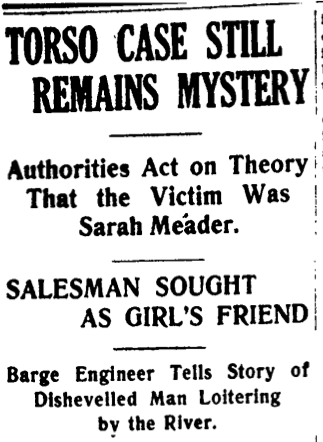
On June 21, 1914, Schenectady police were still puzzling out the mystery of the woman’s torso found in the Mohawk River days before. Police were working on the theory that Miss Sarah Meader of Quaker Springs, Saratoga County, might be the girl; her uncle said she had not been seen since May 25, when she went to Albany with a William Cantrow, “a salesman travelling for a stove concern.” Much didn’t make sense about the story, including the fact that the strongest supposed clue in the case, the mysterious stranger who rented a boat and flopped a burlap bag and a lump of concrete into it, was supposed to have done so on May 20.
In the meantime, police were pursuing any “clew” they were given. Joseph Foley, a barge canal engineer, said he had seen a “stranger of disheveled appearance” loitering on the bank of the Mohawk near Shear’s Quarry on the night of May 30, a mile below where the torso was found. Foley and others were walking along the bank when they saw the man, noting that “he did not have a hat, his shirt was torn open in front and he appeared excited.” Not having a hat in 1914 was very close to a criminal act.
About a dozen other women were considered to potentially be the victim, from as far away as Brooklyn. One was Theresa Faust, an 18-year-old from Germania Street. Miss Faust was visiting her aunt in New York City and, hearing of her own possible demise, walked into the local police station there. The NYPD immediately notified Schenectady Police that she was alive and well, and Schenectady police sent a detective with a warrant for her arrest. Her mother had brought a charge of petty larceny against her, alleging that Theresa took $20 belonging to the mother before she left home.
The Schenectady Board of Supervisors offered a reward of $500 for information on the torso. This bit of morbid logic was attributed to an unidentified member of the police department:
“The head is the key. If we found an arm it might be most helpful, for we might find it marked, or a finger might hold a ring by which identification could be made. It is strange that in the narrow Mohawk some other part of the body has not been found.”
